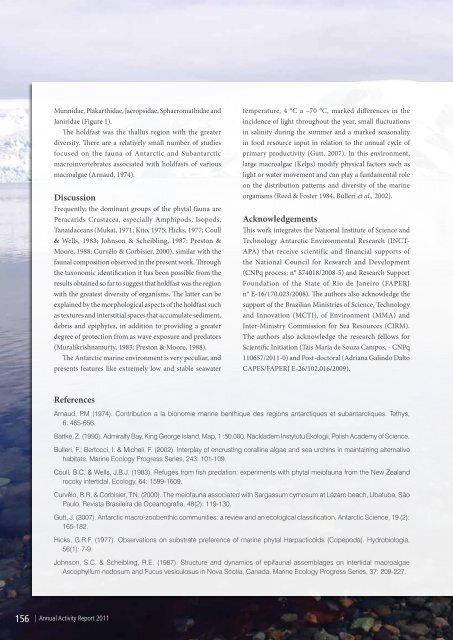1 - Instituto de Biologia da UFRJ
1 - Instituto de Biologia da UFRJ
1 - Instituto de Biologia da UFRJ
Create successful ePaper yourself
Turn your PDF publications into a flip-book with our unique Google optimized e-Paper software.
Munni<strong>da</strong>e, Plakarthi<strong>da</strong>e, Jaeropsi<strong>da</strong>e, Sphaeromathi<strong>da</strong>e and<br />
Janiri<strong>da</strong>e (Figure 1).<br />
The holdfast was the thallus region with the greater<br />
diversity. There are a relatively small number of studies<br />
focused on the fauna of Antarctic and Subantarctic<br />
macroinvertebrates associated with holdfasts of various<br />
macroalgae (Arnaud, 1974).<br />
Discussion<br />
Frequently, the dominant groups of the phytal fauna are<br />
Peracarids Crustacea, especially Amphipods, Isopods,<br />
Tanai<strong>da</strong>ceans (Mukai, 1971; Kito, 1975; Hicks, 1977; Coull<br />
& Wells, 1983; Johnson & Scheibling, 1987; Preston &<br />
Moore, 1988; Curvêlo & Corbisier, 2000), similar with the<br />
faunal composition observed in the present work. Through<br />
the taxonomic i<strong>de</strong>ntification it has been possible from the<br />
results obtained so far to suggest that holdfast was the region<br />
with the greatest diversity of organisms. The latter can be<br />
explained by the morphological aspects of the holdfast such<br />
as textures and interstitial spaces that accumulate sediment,<br />
<strong>de</strong>bris and epiphytes, in addition to providing a greater<br />
<strong>de</strong>gree of protection from as wave exposure and pre<strong>da</strong>tors<br />
(Muralikrishnamurty, 1983; Preston & Moore, 1988).<br />
The Antarctic marine environment is very peculiar, and<br />
presents features like extremely low and stable seawater<br />
temperature, 4 °C a –70 °C, marked differences in the<br />
inci<strong>de</strong>nce of light throughout the year, small fluctuations<br />
in salinity during the summer and a marked seasonality<br />
in food resource input in relation to the annual cycle of<br />
primary productivity (Gutt, 2007). In this environment,<br />
large macroalgae (Kelps) modify physical factors such as<br />
light or water movement and can play a fun<strong>da</strong>mental role<br />
on the distribution patterns and diversity of the marine<br />
organisms (Reed & Foster 1984, Bulleri et al., 2002).<br />
Acknowledgements<br />
This work integrates the National Institute of Science and<br />
Technology Antarctic Environmental Research (INCT-<br />
APA) that receive scientific and financial supports of<br />
the National Council for Research and Development<br />
(CNPq process: n° 574018/2008-5) and Research Support<br />
Foun<strong>da</strong>tion of the State of Rio <strong>de</strong> Janeiro (FAPERJ<br />
n° E-16/170.023/2008). The authors also acknowledge the<br />
support of the Brazilian Ministries of Science, Technology<br />
and Innovation (MCTI), of Environment (MMA) and<br />
Inter-Ministry Commission for Sea Resources (CIRM).<br />
The authors also acknowledge the research fellows for<br />
Scientific Initiation (Tais Maria <strong>de</strong> Souza Campos, - CNPq<br />
110657/2011-0) and Post-doctoral (Adriana Galindo Dalto<br />
CAPES/FAPERJ E-26/102.016/2009).<br />
References<br />
Arnaud, P.M (1974). Contribution a la bionomie marine benthique <strong>de</strong>s regions antarctiques et subantarctiques. Tethys,<br />
6: 465-656.<br />
Battke, Z. (1990). Admiralty Bay, King George Island, Map, 1 :50.000. Nackla<strong>de</strong>m Instytutu Ekologii, Polish Aca<strong>de</strong>my of Science.<br />
Bulleri, F.; Bertocci, I. & Micheli, F. (2002). Interplay of encrusting coralline algae and sea urchins in maintaining alternative<br />
habitats. Marine Ecology Progress Series, 243: 101-109.<br />
Coull, B.C. & Wells, J.B.J. (1983). Refuges from fish pre<strong>da</strong>tion: experiments with phytal meiofauna from the New Zealand<br />
roccky interti<strong>da</strong>l. Ecology, 64: 1599-1609.<br />
Curvêlo, R.R. & Corbisier, T.N. (2000). The meiofauna associated with Sargassum cymosum at Lázaro beach, Ubatuba, São<br />
Paulo. Revista Brasileira <strong>de</strong> Oceanografia, 48(2): 119-130.<br />
Gutt, J. (2007). Antarctic macro-zoobenthic communities: a review and an ecological classification. Antarctic Science, 19 (2):<br />
165-182.<br />
Hicks, G.R.F. (1977). Observations on substrate preference of marine phytal Harpacticoids (Copepo<strong>da</strong>). Hydrobiologia,<br />
56(1): 7-9.<br />
Johnson, S.C. & Scheibling, R.E. (1987). Structure and dynamics of epifaunal assemblages on interti<strong>da</strong>l macroalgae<br />
Ascophyllum nodosum and Fucus vesiculosus in Nova Scotia, Cana<strong>da</strong>. Marine Ecology Progress Series, 37: 209-227.<br />
156 | Annual Activity Report 2011

















